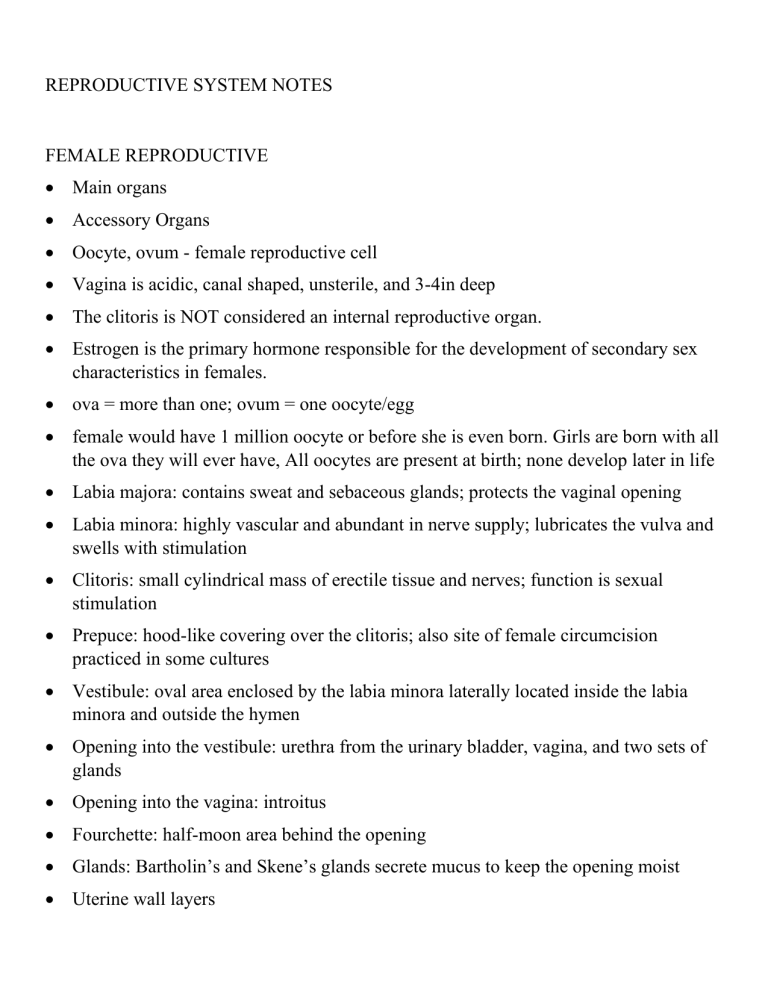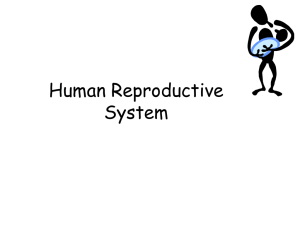
REPRODUCTIVE SYSTEM NOTES FEMALE REPRODUCTIVE Main organs Accessory Organs Oocyte, ovum - female reproductive cell Vagina is acidic, canal shaped, unsterile, and 3-4in deep The clitoris is NOT considered an internal reproductive organ. Estrogen is the primary hormone responsible for the development of secondary sex characteristics in females. ova = more than one; ovum = one oocyte/egg female would have 1 million oocyte or before she is even born. Girls are born with all the ova they will ever have, All oocytes are present at birth; none develop later in life Labia majora: contains sweat and sebaceous glands; protects the vaginal opening Labia minora: highly vascular and abundant in nerve supply; lubricates the vulva and swells with stimulation Clitoris: small cylindrical mass of erectile tissue and nerves; function is sexual stimulation Prepuce: hood-like covering over the clitoris; also site of female circumcision practiced in some cultures Vestibule: oval area enclosed by the labia minora laterally located inside the labia minora and outside the hymen Opening into the vestibule: urethra from the urinary bladder, vagina, and two sets of glands Opening into the vagina: introitus Fourchette: half-moon area behind the opening Glands: Bartholin’s and Skene’s glands secrete mucus to keep the opening moist Uterine wall layers o Endometrium: innermost layer. Lines the uterine cavity in nonpregnant women o Myometrium: muscular middle layer. Makes up the major portion of the uterus. Composed of smooth muscle linked by connective tissue o Perimetrium: outer serosal layer. Covers the body of the uterus. Cervix: the lower part of the uterus Female Sexual Response - Sexual stimulation leading to vasocongestion. Vaginal expansion and elongation. Secretion of mucus by vestibular glands. Estrogen (preservation of vascular function) and testosterone (hormone of sexual desire in women). Orgasm (zenith of stimulation). Rapid dissipation of vasocongestion and muscle contraction. Sexual cycle: desire, excitement, plateau, orgasm, and resolution MALE REPRODUCTIVE Main organs: penis, testes, Accessory Organs: bulbourethral, prostate, vas deferens Produced in testes (testosterones stimulate Leydig cells) Sperm matures in Epididymis The testes need to be slightly cooler than body temperature to allow normal sperm development. Men start producing sperm (Spermatogensis) at puberty till death Sperm is viable for 24HRS Erectile dysfunction due to poor circulation o Based on the male external genitalia, which of the following would be the most logical cause of the inability to achieve an erection? Poor circulation to the penis is the most logical because the penis becomes erect as a result of innervation from the pudendal nerve, which causes the blood vessels to become engorged TestesEpididymisVas deferensSeminal gland ProstateVD becomes the ejaculatory duct joins with urine from bladderto form the urethral tubepenis Male organ outlet for urine, sperm and organ of copulation - penis Scrotum - Sac surrounding and protecting testes. Climate control system for testes. The terminal duct for ejaculation as well as urine - urethra 2 Testes - Sperm production. Testosterone synthesis Male sexual response: Desire, Excitement, Plateau, Orgasm, Resolution FERTILIZATION Fertilization takes places in the fallopian tube. If implantation does not occur the woman’s menstrual cycle will start Zygote is another term for a fertilized ovum. After ejaculation 50-150 million sperm can be released to fertilize 1 egg Source of secretion of the follicle-stimulating hormone (FSH) and the luteinizing hormone (LH)? Anterior Pituitary FEMALE REPRODUCTIVE CYCLE Menarche: womans first menstrual cycle Female Reproductive Cycle #1 Ovarian cycle, Endometrial cycle, Hormonal regulation, Cyclical breast changes, Menstruation (absence of fertilization) Ovarian cycle (Follicular, Ovulation, Luteal Phase) o Follicular phase (day 1 through ovulation, approximately days 10 to 14) o Ovulation (day 14 of a 28-day cycle) o Luteal phase (day 15 through day 28 of a 28-day cycle) Endometrial Cycle (Proliferative, Secretory, Ischemic, Menstrual phase) o Proliferation phase starts on day 5 of the menstrual cycle - till ovulation vascularity of the uterus increase and endometrium become prepared for a fertilized ovum o Secretory phase begins at ovulation to about 3 days before the next menstrual period. o Ischemic o Menstrual Hormonal regulation: Hypothalamus (GnRH), Anterior Pituitary (FSH, LH), Ovaries (Estrogen, progesterone, inhibin, prostaglandin) 3 o The anterior pituitary produces both FSH and LH which are responsible for ovarian follicle maturation. The hypothalamus secretes gonadotropinreleasing hormone to the pituitary gland. The ovaries secrete estrogen and progesterone. The testes secrete testosterone. The posterior pituitary secretes oxytocin (Pitocin) and anti-diuretic hormone. estrogen levels are highest during which phase of the endometrial cycle proliferative MENOPAUSE Perimenopause: can last 2 to 8 years prior to menopause, may start in 30-40’s o Vasomotor symptoms (hot flashes and night sweats) are the most common complaints Menopause is defined as one year (12 months) without a menstrual period, usually between 45 to 55 years of age. True or False: Perimenopause is considered a disease - false 4


